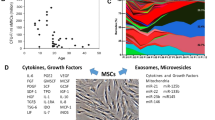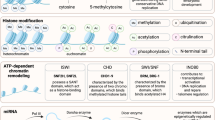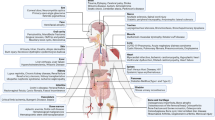Abstract
Mesenchymal stem cells (MSCs) are the focus of intensive efforts worldwide directed not only at elucidating their nature and unique properties but also developing cell-based therapies for a diverse range of diseases. More than three decades have passed since the original formulation of the concept, revolutionary at the time, that multiple connective tissues could emanate from a common progenitor or stem cell retained in the postnatal bone marrow. Despite the many important advances made since that time, substantial ambiguities still plague the field regarding the nature, identity, function, mode of isolation and experimental handling of MSCs. These uncertainties have a major impact on their envisioned therapeutic use.
This is a preview of subscription content, access via your institution
Access options
Subscribe to this journal
Receive 12 print issues and online access
$209.00 per year
only $17.42 per issue
Buy this article
- Purchase on Springer Link
- Instant access to full article PDF
Prices may be subject to local taxes which are calculated during checkout



Similar content being viewed by others
References
Owen, M. & Friedenstein, A.J. Stromal stem cells: marrow-derived osteogenic precursors. Ciba Found. Symp. 136, 42–60 (1988).
Sacchetti, B. et al. Self-renewing osteoprogenitors in bone marrow sinusoids can organize a hematopoietic microenvironment. Cell 131, 324–336 (2007).
Méndez-Ferrer, S. et al. Mesenchymal and haematopoietic stem cells form a unique bone marrow niche. Nature 466, 829–834 (2010).
Bianco, P., Robey, P.G. & Simmons, P.J. Mesenchymal stem cells: revisiting history, concepts, and assays. Cell Stem Cell 2, 313–319 (2008).
Tavassoli, M. & Crosby, W.H. Transplantation of marrow to extramedullary sites. Science 161, 54–56 (1968).
Friedenstein, A.J., Chailakhjan, R.K. & Lalykina, K.S. The development of fibroblast colonies in monolayer cultures of guinea-pig bone marrow and spleen cells. Cell Tissue Kinet. 3, 393–403 (1970).
Caplan, A.I. Mesenchymal stem cells. J. Orthop. Res. 9, 641–650 (1991).
Pittenger, M.F. et al. Multilineage potential of adult human mesenchymal stem cells. Science 284, 143–147 (1999).
Bianco, P. & Robey, P.G. Skeletal stem cells. in Handbook of Adult and Fetal Stem Cells (ed. Lanza, R.P.) 415–424 (Academic Press, San Diego, 2004).
Streeter, G.L. Developmental horizons in human embryos: review of the histogenesis of cartilage and bone. Contrib. Embryol. 33, 149–168 (1949).
Bianco, P., Riminucci, M., Bonucci, E., Termine, J.D. & Robey, P.G. Bone sialoprotein (BSP) secretion and osteoblast differentiation: relationship to bromodeoxyuridine incorporation, alkaline phosphatase, and matrix deposition. J. Histochem. Cytochem. 41, 183–191 (1993).
Bianco, P., Riminucci, M., Kuznetsov, S. & Robey, P.G. Multipotential cells in the bone marrow stroma: regulation in the context of organ physiology. Crit. Rev. Eukaryot. Gene Expr. 9, 159–173 (1999).
Arai, F., Ohneda, O., Miyamoto, T., Zhang, X.Q. & Suda, T. Mesenchymal stem cells in perichondrium express activated leukocyte cell adhesion molecule and participate in bone marrow formation. J. Exp. Med. 195, 1549–1563 (2002).
Maes, C. et al. Osteoblast precursors, but not mature osteoblasts, move into developing and fractured bones along with invading blood vessels. Dev. Cell 19, 329–344 (2010).
Chan, C.K. et al. Endochondral ossification is required for haematopoietic stem-cell niche formation. Nature 457, 490–494 (2009).
Bianco, P. Bone and the hematopoietic niche: a tale of two stem cells. Blood 117, 5281–5288 (2011).
Bush, V. As we may think. Atlantic 101–106 (July 1945).
Bianco, P. & Robey, P.G. Stem cells in tissue engineering. Nature 414, 118–121 (2001).
Bianco, P. et al. Reproduction of human fibrous dysplasia of bone in immunocompromised mice by transplanted mosaics of normal and Gsα-mutated skeletal progenitor cells. J. Clin. Invest. 101, 1737–1744 (1998).
Piersanti, S. et al. Transfer, analysis, and reversion of the fibrous dysplasia cellular phenotype in human skeletal progenitors. J. Bone Miner. Res. 25, 1103–1116 (2010).
Aiuti, A. et al. Correction of ADA-SCID by stem cell gene therapy combined with nonmyeloablative conditioning. Science 296, 2410–2413 (2002).
Mavilio, F. et al. Correction of junctional epidermolysis bullosa by transplantation of genetically modified epidermal stem cells. Nat. Med. 12, 1397–1402 (2006).
Horwitz, E.M. et al. Transplantability and therapeutic effects of bone marrow-derived mesenchymal cells in children with osteogenesis imperfecta. Nat. Med. 5, 309–313 (1999).
Horwitz, E.M. et al. Clinical responses to bone marrow transplantation in children with severe osteogenesis imperfecta. Blood 97, 1227–1231 (2001).
Horwitz, E.M. et al. Isolated allogeneic bone marrow–derived mesenchymal cells engraft and stimulate growth in children with osteogenesis imperfecta: implications for cell therapy of bone. Proc. Natl. Acad. Sci. USA 99, 8932–8937 (2002).
Wright, D.E., Wagers, A.J., Gulati, A.P., Johnson, F.L. & Weissman, I.L. Physiological migration of hematopoietic stem and progenitor cells. Science 294, 1933–1936 (2001).
Bianco, P. & Gehron Robey, P. Marrow stromal stem cells. J. Clin. Invest. 105, 1663–1668 (2000).
Thomas, E.D., Lochte, H.L. Jr., Lu, W.C. & Ferrebee, J.W. Intravenous infusion of bone marrow in patients receiving radiation and chemotherapy. N. Engl. J. Med. 257, 491–496 (1957).
Green, H. Regeneration of the skin after grafting of epidermal cultures. Lab. Invest. 60, 583–584 (1989).
De Luca, M. et al. Permanent coverage of full skin thickness burns with autologous cultured epidermis and reepithelialization of partial skin thickness lesions induced by allogeneic cultured epidermis: a multicentre study in the treatment of children. Burns 18 (suppl. 1), S16–S19 (1992).
Ronfard, V., Rives, J.M., Neveux, Y., Carsin, H. & Barrandon, Y. Long-term regeneration of human epidermis on third degree burns transplanted with autologous cultured epithelium grown on a fibrin matrix. Transplantation 70, 1588–1598 (2000).
Pellegrini, G. et al. Long-term restoration of damaged corneal surfaces with autologous cultivated corneal epithelium. Lancet 349, 990–993 (1997).
Rama, P. et al. Limbal stem-cell therapy and long-term corneal regeneration. N. Engl. J. Med. 363, 147–155 (2010).
Caplan, A.I. The mesengenic process. Clin. Plast. Surg. 21, 429–435 (1994).
da Silva Meirelles, L., Chagastelles, P.C. & Nardi, N.B. Mesenchymal stem cells reside in virtually all post-natal organs and tissues. J. Cell Sci. 119, 2204–2213 (2006).
Dominici, M. et al. Minimal criteria for defining multipotent mesenchymal stromal cells. The International Society for Cellular Therapy position statement. Cytotherapy 8, 315–317 (2006).
Crisan, M. et al. A perivascular origin for mesenchymal stem cells in multiple human organs. Cell Stem Cell 3, 301–313 (2008).
Caplan, A.I. All MSCs are pericytes? Cell Stem Cell 3, 229–230 (2008).
Jain, R.K. Molecular regulation of vessel maturation. Nat. Med. 9, 685–693 (2003).
Díaz-Flores, L. et al. Pericytes. Morphofunction, interactions and pathology in a quiescent and activated mesenchymal cell niche. Histol. Histopathol. 24, 909–969 (2009).
Armulik, A., Genove, G. & Betsholtz, C. Pericytes: developmental, physiological, and pathological perspectives, problems, and promises. Dev. Cell 21, 193–215 (2011).
Dellavalle, A. et al. Pericytes of human skeletal muscle are myogenic precursors distinct from satellite cells. Nat. Cell Biol. 9, 255–267 (2007).
Tang, W. et al. White fat progenitor cells reside in the adipose vasculature. Science 322, 583–586 (2008).
da Silva Meirelles, L., Caplan, A.I. & Nardi, N.B. In search of the in vivo identity of mesenchymal stem cells. Stem Cells 26, 2287–2299 (2008).
Woodbury, D., Schwarz, E.J., Prockop, D.J. & Black, I.B. Adult rat and human bone marrow stromal cells differentiate into neurons. J. Neurosci. Res. 61, 364–370 (2000).
Jiang, Y. et al. Pluripotency of mesenchymal stem cells derived from adult marrow. Nature 418, 41–49 (2002).
Katagiri, T. et al. Bone morphogenetic protein-2 converts the differentiation pathway of C2C12 myoblasts into the osteoblast lineage. J. Cell Biol. 127, 1755–1766 (1994).
Medici, D. et al. Conversion of vascular endothelial cells into multipotent stem-like cells. Nat. Med. 16, 1400–1406 (2010).
Nakashima, K. et al. The novel zinc finger–containing transcription factor osterix is required for osteoblast differentiation and bone formation. Cell 108, 17–29 (2002).
Lee, K.D. et al. In vitro hepatic differentiation of human mesenchymal stem cells. Hepatology 40, 1275–1284 (2004).
Willingham, M.C. & Pastan, I. Cyclic amp and cell morphology in cultured fibroblasts. Effects on cell shape, microfilament and microtubule distribution, and orientation to substratum. J. Cell Biol. 67, 146–159 (1975).
Niibe, K. et al. Purified mesenchymal stem cells are an efficient source for iPS cell induction. PLoS ONE 6, e17610 (2011).
Takahashi, K., Okita, K., Nakagawa, M. & Yamanaka, S. Induction of pluripotent stem cells from fibroblast cultures. Nat. Protoc. 2, 3081–3089 (2007).
Prockop, D.J., Kota, D.J., Bazhanov, N. & Reger, R.L. Evolving paradigms for repair of tissues by adult stem/progenitor cells (MSCs). J. Cell. Mol. Med. 14, 2190–2199 (2010).
Caplan, A.I. & Correa, D. The MSC: an injury drugstore. Cell Stem Cell 9, 11–15 (2011).
Friedenstein, A.J., Chailakhyan, R.K., Latsinik, N.V., Panasyuk, A.F. & Keiliss-Borok, I.V. Stromal cells responsible for transferring the microenvironment of the hemopoietic tissues. Cloning in vitro and retransplantation in vivo. Transplantation 17, 331–340 (1974).
Au, P., Tam, J., Fukumura, D. & Jain, R.K. Bone marrow–derived mesenchymal stem cells facilitate engineering of long-lasting functional vasculature. Blood 111, 4551–4558 (2008).
Melero-Martin, J.M. et al. Engineering robust and functional vascular networks in vivo with human adult and cord blood–derived progenitor cells. Circ. Res. 103, 194–202 (2008).
Moioli, E.K. et al. Synergistic actions of hematopoietic and mesenchymal stem/progenitor cells in vascularizing bioengineered tissues. PLoS ONE 3, e3922 (2008).
Park, D., Sykes, D.B. & Scadden, D.T. The hematopoietic stem cell niche. Front. Biosci. 17, 30–39 (2012).
Haniffa, M.A., Collin, M.P., Buckley, C.D. & Dazzi, F. Mesenchymal stem cells: the fibroblasts' new clothes? Haematologica 94, 258–263 (2009).
Schrepfer, S. et al. Stem cell transplantation: the lung barrier. Transplant. Proc. 39, 573–576 (2007).
Lee, R.H. et al. Intravenous hMSCs improve myocardial infarction in mice because cells embolized in lung are activated to secrete the anti-inflammatory protein TSG-6. Cell Stem Cell 5, 54–63 (2009).
Kuznetsov, S., Riminucci, M., Robey, P.G. & Bianco, P. Post-natal skeletal stem cells: methods for isolation and analysis of bone marrow stromal cells (BMSCs) from post-natal murine and human marrow. in Cell Biology: A Laboratory Handbook (ed. Celis, J.E.) 79–86 (Elsevier, San Diego, 2006).
Acknowledgements
Note that the authors are listed in alphabetical order in the author list. This work was supported in part by grants from Telethon (GGP09227), Fondazione Roma, Ministero dell'Istruzione, dell'Università e della Ricerca (MIUR), Ministero della Salute, EU (Angioscaff) and Fondazione Institut Pasteur-Cenci Bolognetti (to P.B.), the US National Institutes of Health (NIH) (R01 DK056638, HL69438, HL097819, HL097700, HL116340 to P.S.F.), NIH DK57501 (to X.C.), the National Institute of Dental and Craniofacial Research (NIDCR), NIH (DE019412 and DE016513 to C.-Y.W.), NIH R01DE018248 and R01EB009663 to J.J.M. and the Division of Intramural Research, NIDCR of the Intramural Research Program, NIH, Department of Health and Human Services (to P.G.R.).
Author information
Authors and Affiliations
Corresponding author
Ethics declarations
Competing interests
P.J.S. is an employee of Mesoblast Ltd., a company engaged in clinical trials using mesenchymal precursor cells.
Rights and permissions
About this article
Cite this article
Bianco, P., Cao, X., Frenette, P. et al. The meaning, the sense and the significance: translating the science of mesenchymal stem cells into medicine. Nat Med 19, 35–42 (2013). https://doi.org/10.1038/nm.3028
Received:
Accepted:
Published:
Issue Date:
DOI: https://doi.org/10.1038/nm.3028
This article is cited by
-
A single-cell atlas of conventional central chondrosarcoma reveals the role of endoplasmic reticulum stress in malignant transformation
Communications Biology (2024)
-
Adipose tissue-derived human mesenchymal stromal cells can better suppress complement lysis, engraft and inhibit acute graft-versus-host disease in mice
Stem Cell Research & Therapy (2023)
-
Nanotopography reveals metabolites that maintain the immunomodulatory phenotype of mesenchymal stromal cells
Nature Communications (2023)
-
Biology and therapeutic potential of mesenchymal stem cell extracellular vesicles in axial spondyloarthritis
Communications Biology (2023)
-
A mutation in the ZNF687 gene that is responsible for the severe form of Paget’s disease of bone causes severely altered bone remodeling and promotes hepatocellular carcinoma onset in a knock-in mouse model
Bone Research (2023)



